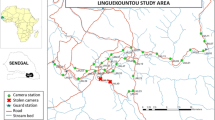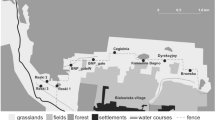Abstract
The Argentine giant tegu, a large lizard native to South America, was first discovered as established in the USA in scrub habitats of west-central Florida in 2006. Invasive populations potentially could occupy an extensive range of habitats and in much of the southern United States and Mexico and threaten many native species. The Argentine giant tegu was recently deemed as having a “highest impact concern” among the invasive reptile species most threatening to Florida ecology. Among the most rewarding research directions identified for this species was “having a reliable and practical method to detect/monitor” them. We address this need by evaluating five methods for monitoring Argentine giant tegus on how well each method detected the species and whether the observations were sufficient to quantitatively assess population abundance using a widely applicable framework for indexing animal populations. Passive tracking plots were the most efficient and effective means for detecting tegus and calculating abundance indices but were best suited for late winter to spring before summer rains compacted tracking substrates. Gopher tortoise burrows are often used by tegus and camera traps on their entrances proved able to obtain data suitable for indexing populations but required more labor and expense than tracking plots. Trapping either at gopher tortoise burrows or along drift fences was ineffective at capturing tegus. Similarly, visual encounter transects were not effective for observing tegus.








Similar content being viewed by others
References
Allen BL, Allen LR, Engeman RM, Leung, LK.-P. (2014) Sympatric prey responses to lethal predator control: predator manipulation experiments. Front Zool 11:56
Allen LR, Engeman RM (2015) Evaluating and validating abundance monitoring methods in absence of populations of known size. Environ Sci Pollut Res 22:2907–2915
Allen BL, Allen LR, Engeman RM, Leung LK-P (2013) Intraguild relationships between sympatric predators exposed to lethal control: predator manipulation experiments. Front Zool 10:39
Ashton PS, Ashton RE Jr (2004) The gopher tortoise: a life history. Pineapple Press, Sarasota
Avery ML, Tillman EA, Krysko KL (2009) Gopherus polyphemus (gopher tortoise), Ctenosaura similis (Gray’s spiny-tailed iguana). Predation Herpetol Rev 40:435
Avery ML, Humphrey J, Engeman RM (2016) Evaluating trap alternatives for removal of black and white tegus Salvator merianae. Southeast Nat 15:107–113
Baldwin RA, Quinn N, Davis DH, Engeman RM. (2014) Effectiveness of rodenticides for managing invasive roof rats and native deer mice control in orchards. Environ Sci Pollut Res 21:5795–5802
Balsai M (1998) Tegus: South America’s cunning teiids. Reptiles 6(9):52–69
Bartlett RD, Bartlett PP (1999) A field guide to Florida reptiles and amphibians. Gulf Publishing Co., Houston
Caughley G (1977) Analysis of vertebrate populations. Wiley, New York
Corn ML, Buck EH, Rawson J, Segarra A, Fischer E (2002) Invasive non-native species: background and issues for Congress. Congressional Research Service and The Library of Congress, Washington, DC
Cope ED. (1875) Check-list of North-American Batrachia and Reptilia. Bulletin of the United States National Museum 1:1–104
Enge KM (2007) FWC bioprofile for the Argentine black and white tegu (Tupinambis merianae). Florida Fish and Wildlife Conservation Commission report, Tallahassee
Enge KM, Kaiser BW, Dickerson RB. (2006) Another large exotic lizard in Florida, the Argentine black and white tegu. In: Proceedings of the 28th Annual Gopher Tortoise Council Meeting. Gopher Tortoise Council, Valdosta, Georgia Npn
Engeman RM (2005) A methodological and analytical paradigm for indexing animal populations applicable to many species and observation methods. Wildl Res 32:203–210
Engeman R, Allen LR (2000) Overview of a passive tracking index for monitoring wild canids and associated species. Integr Pest Manag Rev 5:197–203
Engeman RM, Avery ML (2016) Prioritizing management and research actions against invasive reptiles in Florida: a collaboration by an expert panel. Herp Alliance and USDA/WS/National Wildlife Research Center, Fort Collins
Engeman RM, Pipas MJ, Gruver KS, Allen L (2000) Monitoring coyote populations with a passive activity index. Wildl Res 27:553–557
Engeman RM, Massei G, Sage M, Gentle M. (2013) Monitoring wild pig populations: a review of methods. Environ Sci Pollut Res 20:8077–8091
Engeman RM, Constantin BU, Nelson M, Woolard J, Bourassa J (2001) Monitoring changes in feral swine population and spatial distribution of activity. Environ Conserv 28:235–240
Engeman RM, Woolard JW, Perry ND, Witmer G, Hardin S, Brashears L, Smith HT, Muiznieks B, Constantin BU (2006) Rapid assessment for a new invasive species threat: the case of the Gambian giant pouched rat in Florida. Wildl Res 33:439–448
Engeman RM, Stevens A, Allen J, Dunlap J, Daniel M, Teague D, Constantin BU (2007) Feral swine management for conservation of an imperiled wetland habitat: Florida’s vanishing seepage slopes. Biol Conserv 134:440–446
Engeman RM, Constantin BU, Hardin S, Smith HT, Meshaka WE Jr (2009a) “Species pollution” in Florida: a cross-section of invasive vertebrate issues and management responses. In: Wilcox CP, Turpin RB (eds) Invasive species: detection, impact and control. Nova Science Publishers, Hauppauge, pp 179–197
Engeman RM, Kennedy M, Constantin BU, Christie ML, Hall PT (2009b) Ctenosaura similis (black spinytail iguana), Gopherus polyphemus. (gopher tortoise) concurrent burrow use. Herpetol Rev 40:84
Engeman RM, Jacobson E, Avery M, Meshaka WE Jr (2011) The aggressive invasion of exotic reptiles in Florida with a focus on prominent species: a review. Curr Zool 57:599–612
Engeman RM, Allen BL, Allen LR (2017) Study design concepts for inferring functional roles of mammalian top predators. Special issue on “Strengths, weaknesses, opportunities and threats to the study and conservation of top-predators and their role in terrestrial food webs”. Food Webs 12:56–63
FNAI (Florida Natural Areas Inventory) (2010) Guide to the natural communities of Florida. Florida Natural Areas Inventory and Florida Department of Natural Resources, Tallahassee
Franzetti B, Ronchi B, Marini F, Scacco M, Calmanti R, Calabrese A, Paola A, Paolo M, Focardi S (2012) Nocturnal line transect sampling of wild boar (Sus scrofa) in a Mediterranean forest: long-term comparison with capture–mark–resight population estimates. Eur J Wildl Res 58:385–402
FWC (Florida Fish and Wildlife Conservation Commission) (2015) Tegus in Florida. In: Florida Fish and Wildlife Conservation Commission. FL, Tallahassee
Galetti M, Bovendorp RS, Fadin RF, Gussoni COA, Rodrigues M, Alvarez AD, Guimaraes PR, Alves K (2009) Hyper-abundant mesopredators and bird extinction in an Atlantic forest island. Zoolog 26:288–298
Hardin S (2007) Managing non-native wildlife in Florida: state perspective, policy and practice. In: Witmer G, Pitt W, Fagerstone K (eds) Managing Vertebrate Invasive Species: Proceedings of an International Symposium. USDA/APHIS/WS, National Wildlife Research Center, Fort Collins, pp 43–52
Hare KM (2012) Herpetofauna: systematic searches v1.0. Inventory and monitoring toolbox: herpetofauna. Department of Conservation, Wellington
Jackson JA, Jackson BJS (2007) An apparent mutualistic association between invasive exotics: Brazilian pepper (Schinus terebinthifolius) and black spiny-tailed iguanas (Ctenosaura similis). Nat Areas J 27:254–257
Jarnevich CS., Hayes MA, Fitzgerald LA, Yackel Adams AA, Falk BG, Collier MAM, Bonewell LR, Klug PE, Naretto S, Reed RN. (2018) Modeling the distributions of tegu lizards in native and potential invasive ranges. Scientific Reports. Online first
Johnson SA, McGarrity M (2017) Florida invader: tegu lizard. University of Florida/IFAS Extension, Gainesville
Kaiser BW, Osorio KJ, Enge KM, Engeman RM (2013) Tupinambis merianae (Argentine giant tegu), Pantherophis gutattatus guttatus (red rat snake). Nonpredatory killing SSAR. Herpetol Rev 44:329
King D, Green B, Herrera E (1994) Thermoregulation in a large teiid lizard, Tupinambis teguixin, in Venezuela. Copeia 1994:806–808
Krebs CJ (1998) Ecological methodology. Benjamin/Cummings, Menlo Park
Lambert MRK (2002) Amphibians and reptiles. In: Grant IF, Tingle CCD (eds) Ecological monitoring methods for the assessment of pesticide impact in the tropics. Natural Resources Institute, Chatham, pp 213–227
Lopes HR, Abe AS. (1999) Biologia reprodutivo e comportamento do teiú, Tupinambis merianae, em cativeiro (Reptilia, Teiidae). In: Fang TG, Montenegro OL, Bodme RE (Eds.). Manejo y Conservación de Fauna Silvestre en América Latina. Instituto de Ecología, La Paz, Bolivia. pp 259–272
Luxmoore R, Groombridge B, Broads S (eds) (1988) Significant Trade in wildlife: a review of selected species in CITES Appendix II. Volume 2: Reptiles and invertebrates. IUCN Conservation Monitoring Centre, Cambridge
McEachern MA, Yackel Adams AA, Klug PE, Fitzgerald LA, Reed RN (2015) Brumation of introduced black and white tegus, Tupinambis merianae (Squamata: Teiidae), in Southern Florida. Southeast Nat 14(2):319–328
Mercolli C, Yanosky A (1994) The diet of adult Tupinambis teguixin (Sauria: Teiidae) in the eastern chaco of Argentina. Herpetol J 4:15–19
Meshaka WE Jr, Butterfield BP, Hauge JB (2004) The exotic amphibians and reptiles of Florida. Krieger Publishing Company, Malabar
Meshaka WE Jr, Smith HT, Engeman RM, Dean CL, Moore JA, O’Brien WE (2005) The geographically contiguous and expanding range of the northern curlytail lizard (Leicephalus carinatus armouri) in Florida. Southeast Nat 4:521–526
Meshaka WE Jr (2011) Runaway train in the making: the exotic amphibians, reptiles, turtles, and crocodilians of Florida. Monograph 1. Herpetol Conserv Biol 6:1–101
Ryan DA, Heywood A (2003) Improving the precision of longitudinal ecological surveys using precisely defined observational units. Environmetrics 14:83–293
SFWMD (South Florida Water Management District) (2008) Executive Summary 2008 South Florida Environmental Report. South Florida Water Management District, West Palm Beach
U.S. Congress (1993) Harmful non indigenous species in the United States. Office of Technology Assessment, OTA F 565 Government Printing Office, Washington DC
Vitt LJ (1995) The ecology of tropical lizards in the Caatinga of Northeast Brazil. Occasional Papers of the Oklahoma Museum of. Nat Hist 1:1–29
Acknowledgments
This research was supported by the intramural research program of the U.S. Department of Agriculture; Hillsborough County Conservation and Environmental Lands Management Department; partial funding for this project was provided through Cooperative Agreement No. 40181AJ085 between Hillsborough County Conservation and Environmental Lands Management Department and the U.S. Fish and Wildlife Service.
Author information
Authors and Affiliations
Corresponding author
Additional information
Responsible editor: Philippe Garrigues
Publisher’s note
Springer Nature remains neutral with regard to jurisdictional claims in published maps and institutional affiliations.
Rights and permissions
About this article
Cite this article
Engeman, R.M., Kaiser, B.W. & Osorio, K.J. Evaluating methods to detect and monitor populations of a large invasive lizard: the Argentine giant tegu. Environ Sci Pollut Res 26, 31717–31729 (2019). https://doi.org/10.1007/s11356-019-06324-2
Received:
Accepted:
Published:
Issue Date:
DOI: https://doi.org/10.1007/s11356-019-06324-2




